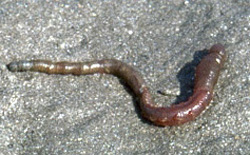How much toxic metal does it take to kill a worm?
Metals such as zinc, cadmium, silver and arsenic are released into the environment from industrial and other anthropogenic sources. The impacts on local ecosystems can be devastating, though the pathways from source to receptor are often complex and difficult to model. A detailed investigation of this phenomenon was undertaken in the context of the 'Biodynamic modelling of toxic metal accumulation by the lugworm Arenicola marina, a keynote deposit feeding polychaete in European estuaries' (Dynolug) project. The lugworm is an ideal model organism since it consumes sediments in estuaries, many of which have been contaminated by nearby factories. Field data collected in southwest England were used to refine the way a kinetic model parameterises mechanisms for take-up and storage of metals by lugworms. The model was then successfully validated through a series of experiments in the laboratory where lugworms were exposed to varying concentrations of several different metals. One of the objectives of Dynolug was to establish a threshold metal concentration which, when exceeded, resulted in certain death of the lugworm. What the researchers discovered was that this was not as straightforward as expected since it was possible for the lugworm to safely store away part of the ingested metal, the so-called detoxified fraction. This resonates well with other research being carried out in this field and highlights the importance of understanding and accounting for detoxification mechanisms. The Dynolug findings and the increased accuracy of the model will be of value to water management authorities as they strive to meet the requirements of the EU's Water Framework Directive and other legislation.







